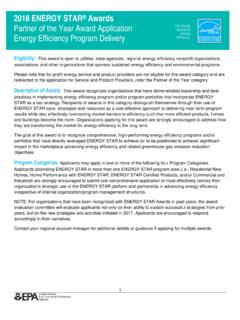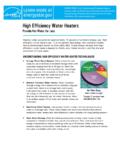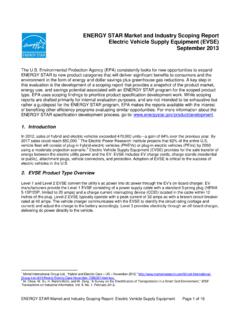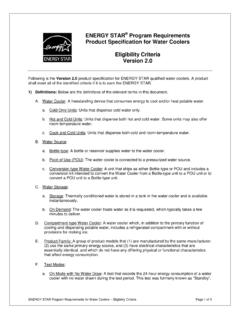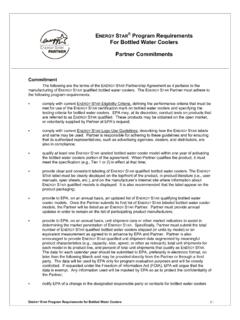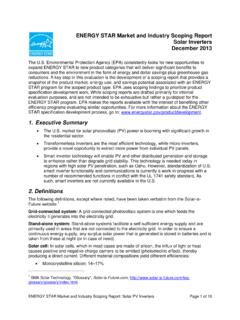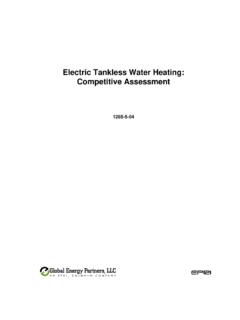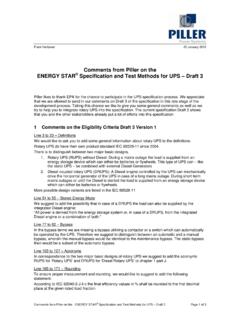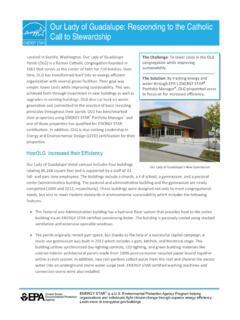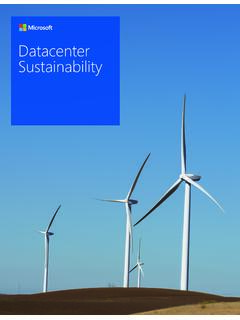Transcription of Healthcare: An Overview of Energy Use and Energy ...
1 Healthcare: An Overview of Energy Use and Energy efficiency Opportunities Energy Use in Healthcare Healthcare organizations spend over $ billion on Energy each year, and that amount is rising to meet patients' needs. By being more Energy efficient, hospitals around the country can save money, help prevent greenhouse gas emissions, improve the air quality of their communities, and support their commitment to public health. Hospitals protect their bottom line by being more Energy efficient every $1 a non-profit healthcare organization saves on Energy is equivalent to generating $20 in new revenues for hospitals or $10 for medical offices. For-profit hospitals, medical offices, and nursing homes can raise their earnings per share a penny by reducing Energy costs just 5 percent. By being more Energy efficient and saving money, hospitals can reinvest savings from improved Energy performance.
2 Energy efficiency Opportunities Healthcare Organizations Making a Healthcare organizations can find Energy savings through multiple efforts. Difference: Low-Cost Measures New York Presbyterian Hospital (NYPH) has set > Measure and track Energy performance. and implemented rigorous Energy savings targets and projects since 2003, resulting in approximately > Ensure all equipment is functioning as specified and designed. $ million in annual savings. Because of its exceptional and continuous achievements, NYPH. > Retrofit inefficient lighting. is the first healthcare system to earn the Energy . > Adjust thermostats for seasonal changes and occupancy. STAR Partner of the Year Award three times. > Install variable frequency drives (VFDs) and Energy -efficient motors. Providence Health and Services, a Seattle-based healthcare system serving the Pacific Northwest > Balance air and water systems.
3 And Southern California, leveraged their 2004. > Educate staff and patients about how their behaviors affect Energy use. Energy STAR Partner of the Year Award to further embed Energy management into their > Use Energy STAR Target Finder to integrate efficiency goals into the design of organizational structure by establishing a new properties. corporate Office of Energy Management. Their Energy savings have increased from $700,000 in Cost-Effective Investments 2003 to $ million in 2006. > Work with an Energy service provider to help manage and improve Energy performance. > Investigate capital investments such as highly efficient HVAC systems. > Purchase Energy -efficent products like Energy STAR qualified office, electronic, and commercial cooking equipment. How to Talk to Healthcare Organizations About Energy efficiency There are several key individuals to contact when seeking to improve the Energy efficiency of healthcare organizations.
4 You will need to gain the support of senior administrators ( the CEO, chief financial officer, Energy STAR Offers chief operations officer) as well as the facilities manager and/or director of engineering. Working with senior - Guides and manuals - Facility benchmarking executives can be the most effective path to follow since top level support for Energy management will drive - Training organization-wide participation. - Institutional purchasing - Technical support - Financing resources However, hospitals have many urgent and pressing needs, such as maintaining a safe environment for - Emissions reporting patients, budget constraints, inspections, or staff retention issues. Energy management is often a low priority - Third-party recognition - Motivational campaigns for executives who have many competing priorities and who may believe Energy is just a fixed cost of doing business.
5 Energy STAR is a government-backed program helping businesses and individuals protect the environment through superior Energy efficiency . Healthcare: An Overview of Energy Use and Energy efficiency Opportunities How to Talk to Healthcare Organizations About Energy efficiency (cont.). Nonetheless, CEOs consistently list financial challenges as their number one concern. Senior executives will most likely respond favorably when efficiency programs are presented as cost containment or strategic risk reduction initiatives. Showing that Energy management can add value to the bottom line and reduce a hospital's vulnerability to Energy price hikes provides CEOs greater incentive to support Energy efficiency initiatives. Improving community public health through pollution prevention is another compelling reason for healthcare institutions to improve building efficiency .
6 Engaging representatives from Facilities Management or Engineering is a slightly different matter. When hospital administrators ask them to look for savings, often the two largest categories in their operations budget are utilities and salaries. In many respects, saving Energy helps save jobs in facility operations. The good news is facility managers don't have to procure new technologies to start. Significant savings can be made by focusing on improving the Energy performance of existing equipment. Recalibrating thermostats and occupancy sensors, adjusting operating schedules, and rebalancing the air and water flows of the HVAC system are just a few ways to improve occupant comfort and save Energy costs in the near term. Energy STAR Resources Guidelines for Energy Management: Based on the successful practices of Energy STAR partners, these guidelines can assist healthcare organizations in improving their Energy and financial performance while designating themselves as environmental leaders.
7 Portfolio Manager Measure and Track Energy Performance: By measuring, setting goals, and tracking Energy use, hospitals can gain control of Energy expenses. Eligible hospital campuses and medical office buildings can rate their Energy performance on a scale of 1 to 100 relative to similar buildings nationwide. To date, EPA's Energy performance rating system has been used to measure and track the Energy use of more than a third of hospitals. Perform Cost-Effective Building Upgrades: Plan systematic building upgrades using the 5-stage approach in EPA's Building Upgrade Manual. This online handbook offers guidance for each stage, from commissioning to plant upgrades. Other Resources for Healthcare: Recognition for Achievements American Society for Healthcare Engineering's Energy efficiency Commitment (ASHE E2C). Earn the Energy STAR: Buildings that rate in the top 25 percent of Energy -efficient ( ): This buildings in the nation may qualify for the Energy STAR label.
8 Healthcare engineering association has partnered with Energy STAR to launch an Energy efficiency initiative to share fundamental concepts, proven strategies, financial tools, local success stories by ASHE E2C members, and recognition. Become an Energy STAR Leader: Energy STAR Partners who demonstrate continuous Hospitals for a Healthy Environment (H2E). improvement system-wide, not just in individual hospitals, may qualify for recognition as ( ): H2E aims to create a Energy STAR Leaders. EPA will recognize systems that have achieved reductions of 10, national movement for environmental sustainability in healthcare. 20, 30 percent, or more. Visit for more information on Energy STAR resources and recognition. Energy STAR is a government-backed program helping businesses and individuals protect the environment through superior Energy efficiency .
